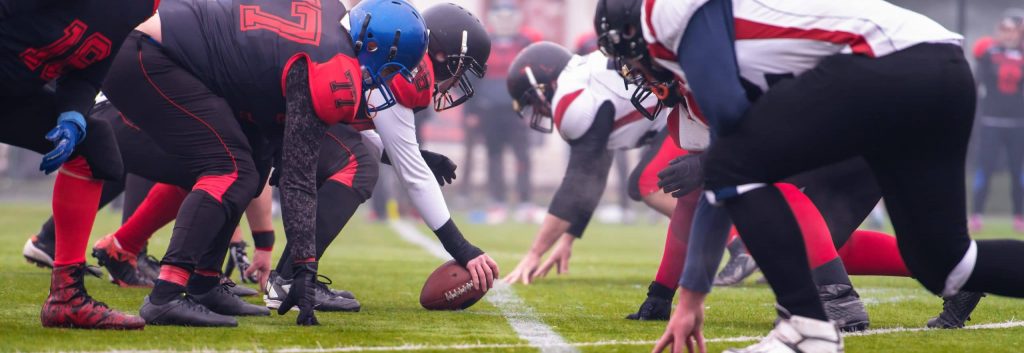
The Most Common Orthopedic Injuries in Football
Since football season’s kicked off, our Sports Medicine Specialists at Northern Arizona Orthopaedics know that potential for injury emerges with every game and every practice. Whether you’re the athlete or a supportive spectator, here is what you should know about the most common orthopedic injuries resulting from high speeds and full contact.
Shoulder Injuries
Most football-related shoulder injuries occur when a player gets tackled to the ground. The impact of the hit or fall onto the outstretched arm can dislocate the shoulder. In more severe dislocations, the soft tissue connections around the acromioclavicular joint (AC joint), where the collarbone connects to the scapula above the shoulder, can be damaged or torn. Commonly referred to as a ‘shoulder separation,’ this injury can most often be treated without surgery, but in some instances may lead to ongoing discomfort or shoulder dysfunction with throwing activities.
Due to the repetitive overhand motion involved in throwing, quarterbacks can be at an increased risk for developing injuries related to overuse of their shoulder, including rotator cuff tears. Rotator cuff tears may be partial or complete. Although rotator cuff tears are rare in the young athlete population, a partial tear occurs when a tendon becomes frayed or damaged and a complete tear is when the tendon is torn more than 50% or is pulled completely away from the bone. However, most rotator cuff tears occur in adults and are associated with prolonged wear and tear as we age.
For more information on shoulder injuries, click here.
Knee Injuries
Knee injuries are the most common injuries in football and often occur after a sudden twist or direct blow to the knee. Two of the most common injuries are tears to the anterior cruciate ligament (ACL) and meniscus tears.
With an ACL injury, often the feeling of a “pop” is reported at the moment of injury. As one of the main stabilizing ligaments of the knee, ACL tears can lead to instability in the knee and the feeling of the knee buckling or giving out. Pain and swelling are often common signs of injury and surgery may be recommended to restore knee function, depending upon the severity of the tear.
Meniscus tears of the knee can vary widely in severity and pain and often occur alongside other knee injuries, such as an ACL tear. Each knee has two menisci, which are the specialized cartilage providing cushioning between the bones in the knee. Twisting of the knee or forceful contact can lead to the meniscus tearing. In the instance of a torn meniscus, many players report pain, swelling and the feeling of the knee catching or “locking” when standing or walking.
For more information on knee injury treatment, click here.
Foot and Ankle Injuries
An ankle sprain is the result of the ankle twisting, rolling or landing awkwardly after a jump or change in direction. The ankle joint’s ligaments stretch beyond tolerance causing a strain or small tears in the ligaments. This results in pain, swelling and limited mobility and may last for several weeks.
Another chronic football injury is Achilles tendonitis, which is caused from overuse of the band of tissue connecting the calf muscle to the heel bone. The pain usually begins as a mild ache above the heel bone but, in some advanced cases if left untreated, the tendon can become damaged and lead to a tendon rupture.
For more information on foot & ankle care, click here.
Fractures
Football players are frequently placed at higher risk of experiencing fractures than other athletes. From every catch to each tackle, players are constantly using their hands, which can result in fractured fingers. Through a tough tackle or hard fall, a player can fracture the shoulder, clavicle or pelvis—the latter known as a hip pointer. A Jones fracture in the fifth metatarsal, the long bone connecting the smallest toe to the rest of the foot, often occurs from repetitive motion, overuse or after rolling the ankle.
For more information on fracture care, click here.
Seeking Treatment
Yuri Lewicky, MD, an Orthopedic Surgeon specializing in Sports Medicine and Adult Joint Reconstruction at Northern Arizona Orthopaedics, suggests athletes listen to their bodies because pain often reminds an injury it needs rest.
“After an injury occurs, I would advise players against playing through the pain and risking their health for reward,” Dr. Lewicky said. “It’s important for athletes to seek treatment from an experienced sports medicine professional because an early assessment of an injury can lead to faster recovery and a full return to activity.”
Prevention
Heeding precautions both on and off the football field can help protect players from injury. Obtaining a pre-season physical from a Sports Medicine Specialist, performing proper stretches, warm-up and cool-down routines and wearing properly fitted protective equipment serve as proven preventative measures. Also, staying hydrated will help minimize fatigued athletic performance, which can result in injury.
If you are concerned about football injuries, or interested in prevention strategies, seek advice from an expert. Many specialists at Northern Arizona Orthopaedics have experience working with sports teams of all levels, ranging from high school to the professional level, and are dedicated to getting you back in the game.
If a sports injury has sidelined you, contact Northern Arizona Orthopaedics. Our trusted orthopedic specialists are committed to restoring you to an active lifestyle as quickly and safely as possible.
- Lumbar Decompression - December 22, 2020
- Everything You Want To Know About Meniscus Tears - December 1, 2020
- Conventional vs. Robotic-Arm Assisted Knee Arthroplasty - December 1, 2020

